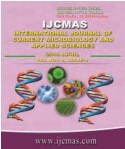


 National Academy of Agricultural Sciences (NAAS)
National Academy of Agricultural Sciences (NAAS)

|
PRINT ISSN : 2319-7692
Online ISSN : 2319-7706 Issues : 12 per year Publisher : Excellent Publishers Email : editorijcmas@gmail.com / submit@ijcmas.com Editor-in-chief: Dr.M.Prakash Index Copernicus ICV 2018: 95.39 NAAS RATING 2020: 5.38 |
One of the common causes of morbidity and mortality following burn injury is infections. The emergence of metallo-β-lactamase (MBL) in Gram negative bacilli (GNB) has reduced the available therapeutic options for effective treatment. Therefore, for screening of carbapenemase producers, a simple and inexpensive testing method is essential. To know the prevalence of MBL production in various gram negative isolates, to evaluate different phenotypic methods to detect MBL production and to find out antibiotic sensitivity profile of MBL producing gram negative bacilli. Wound swabs taken from about 100 patients admitted in the burns ward were processed. Kirby Bauer Disc diffusion test was performed on all isolates for antimicrobial susceptibility. Imipenem resistant clinical isolates were taken as positive for MBL screening. Two different methods using EDTA as MBL inhibitor were evaluated: (i) Combined disk synergy test with imipenem (CDST-IPM), (ii) Double-disk synergy test with imipenem (DDST-IPM), according to CLSI guidelines. The most common isolate was Pseudomonas aeruginosa (23%), followed by Staphylococcus aureus (22%), Escherichia coli (14%), Klebsiella pneumoniae (9%), Klebsiella oxytoca (8%),CONS(7%), Proteus mirabilis (5%), Citrobacterfreundii (4%), Citrobacter koseri (3%) and Acinetobacterbaumanii (2%).Out of 82 Gram negative isolates, 17 were resistant to imipenem and were considered screening positive and further tested for MBL production out of which only10 isolates were confirmed as MBL producers. A.baumanii was the predominant MBL producer followed by P.aeruginosa. MRSA rate among S.aureus was 56%, but all were susceptible to glycopeptides and oxazolidinone. Early detection of MBL-carrying organisms, is of paramount clinical importance, as it allows rapid initiation of strict infection control practices as well as therapeutic guidance for confirmed infection.
 |
 |
 |
 |
 |